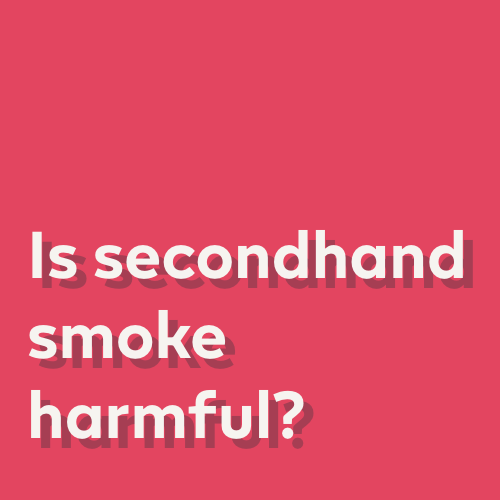Passive smoking occurs when someone who is not smoking breathes in tobacco smoke, such as cigarette smoke.
It is also known as secondhand smoke. Secondhand smoke is a combination of the smoke produced from the lit end of a cigarette (or other combusted tobacco product) and the smoke exhaled by smokers. Public health authorities have concluded that secondhand smoke from burning tobacco causes diseases, including lung cancer and heart disease, in nonsmoking adults, as well as conditions in children such as asthma, respiratory infections, cough, wheezing, otitis media (middle ear infection), and sudden infant death syndrome.
In addition, public health officials have concluded that secondhand smoke can exacerbate adult asthma and cause eye, throat, and nasal irritation. People should be informed about these conclusions and guided by them in deciding whether to be in places where secondhand smoke is present or, if they are smokers, when and where to smoke around others. Smokers should not smoke around children or pregnant women.
Are passive smoking and secondhand smoking the same thing?
Yes, in general passive smoking and secondhand smoking refer to the same thing.
What is passive smoking?
Passive smoking is the act of unintentionally inhaling nearby sources of tobacco smoke. This can happen if one is standing too close to a smoker who is smoking a cigarette, or even if one is too close to the lit end of a cigarette.
Once cigarette smoke is in the air, it has the potential to be inhaled by those in its vicinity. Is passive smoking as worse than smoking? Public health authorities have concluded that the secondhand smoke causes certain diseases as mentioned above.
What is secondhand smoke?
Secondhand smoke is the smoke that is created by a smoker when they are smoking a cigarette, or the smoke that is emitted from the lit end of a cigarette. This is the smoke that has the potential to be “passively smoked” by anyone who is close to it.
Secondhand smoking facts
- Public health authorities have concluded that secondhand smoke from burning tobacco causes diseases, including lung cancer and heart disease, in nonsmoking adults, as well as conditions in children such as asthma, respiratory infections, cough, wheezing, otitis media (middle ear infection), and sudden infant death syndrome.
- In addition, Public health officials have concluded that secondhand smoke can exacerbate adult asthma and cause eye, throat, and nasal irritation.
- People should be informed about these conclusions and guided by them in deciding whether to be in places where secondhand smoke is present.
- Smokers should not smoke around children or pregnant women.
Are there dangers of passive smoking or secondhand smoke for non-smokers?
Public health authorities have concluded that the secondhand smoke causes certain diseases as mentioned above.
How to create a smoke-free environment?
If you are an adult smoker, here are some tips on how to create a smoke-free environment.
Quit smoking entirely. The best way to eliminate secondhand smoke is to quit smoking. This is of course the best course of action for any smoker. Smokers should not smoke around children or pregnant women.
Make the house smoke-free. It’s not enough to just open a window or door, or smoke in another room of the house. Smoke can linger in the air after you’ve had a cigarette. People should be guided by public health authorities’ conclusions in deciding whether to be in places where secondhand smoke is present or, if they are smokers, when and where to smoke around others.
Make the vehicle smoke-free. Similar to smoking in the house, the car is another enclosed space best left smoke-free. Having the windows down in a car will not make a big difference, as smoke can cling to the car seats and linger in the air.
People should be guided by public health authorities’ conclusions in deciding whether to be in places where secondhand smoke is present or, if they are smokers, when and where to smoke around others.
Respect smoke-free zones. Be aware before you light up a cigarette and observe the area around you carefully – especially if you are traveling and unfamiliar with local laws and customs.
Is e cigarette vapor harmful to non-smokers?
Electronic cigarettes, or vapes, are another kind of smoke-free alternative available for adults who would otherwise continue to smoke or use nicotine products. E cigarettes are considered a smoke-free alternative as usually they heat an e liquid to produce a vapor or aerosol, rather than create smoke from burning tobacco.
Learn more about e-cigarettes and how they differ from heated tobacco.
With that in mind, many wonder if vaping produces secondhand smoke. In general, e cigarettes should not burn liquid or generate smoke and therefore have the potential to emit significantly fewer and lower levels of harmful and potentially harmful chemicals compared to cigarette smoke.
The lack of combustion and the reduction in formation of harmful chemicals should be substantiated on a product-by-product basis. Importantly, this does not mean that smoke-free products including e cigarettes are risk free.
Without question, the best decision any smoker can make is to quit tobacco and nicotine use altogether.
Smoke-free product users should always be mindful of others before using any nicotine containing products around non-smokers, minors and people with certain medical conditions and pregnant women.
This article is for general information and educational purposes. Some of the information in this article is based on external, third-party sources and we make no representations or warranties of any kind regarding the accuracy, validity or completeness of such information.

